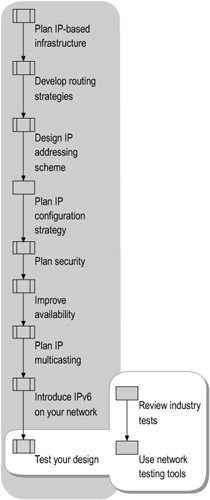Testing Your Design
After acquiring any new hardware and software that your network design requires, systematically measure the new solution against your organization's business and technical goals. Testing your design before deploying it in a production environment ensures that those goals are met with minimum impact.
Predeployment testing lets you assess the performance characteristics of network devices and technologies. Testing also helps you identify deployment-related risks, and instills confidence in the deployment process throughout your organization.
Figure 1.19 shows the process for testing a TCP/IP network design.

Figure 1.19: Testing Your Network Design
Reviewing Industry Tests
Vendors, trade journals, and independent test labs extensively test devices and other network solutions. You might find their published results useful for validating or rejecting assumptions. Keep in mind that most lab tests are component tests rather than system tests and can fail to measure how a particular network design might impact the performance of the specific device or technology.
Using Network Testing Tools
Use the following types of tools to test your network design:
-
Modeling and simulation tools
-
Network management and monitoring tools
Modeling and simulation tools
Use statistical analysis and modeling techniques to simulate a mathematical model of a network. By creating a model, you can isolate potential performance problems before you actually deploy any part of an IP network. In most cases, these tools do not measure actual traffic behavior, so evaluate the results with this limitation in mind.
Network management and monitoring tools
Typically, you use network management and monitoring tools after deploying a network. However, these tools can also help you test your IP network design in a lab. You can use a number of effective commercially available network management applications to identify problems and potential problems on your test network.
Many of these applications run on dedicated network management stations (NMSs) and communicate with internetworking devices using Simple Network Management Protocol (SNMP) or Remote Monitoring (RMON). By using data supplied by an SNMP or RMON Management Information Base (MIB) located on the devices, a network management application can isolate performance problems in a proposed network design.
Windows Server 2003 includes the Network Monitor tool (Netmon.exe), a protocol analyzer that you can use to monitor a new network design. Network Monitor captures and displays packets, analyzing their traffic patterns, rate of broadcast, errors, utilization, and other aspects of their behavior.
The Network Monitor component that ships with Windows Server 2003 can capture frames that are sent to or from the computer on which Network Monitor is installed. To capture frames that are sent to or from a remote computer, you can use the Network Monitor component that ships with Microsoft Systems Management Server (SMS), which can capture frames sent to or from any computer on which the Network Monitor driver is installed.
For more information about the Network Monitor component, see Help and Support Center for Windows Server 2003. For more information about the SMS Network Monitor component, see the SMS Downloads link on the Web Resources page at http://www.microsoft.com/windows/reskits/webresources.
EAN: N/A
Pages: 146